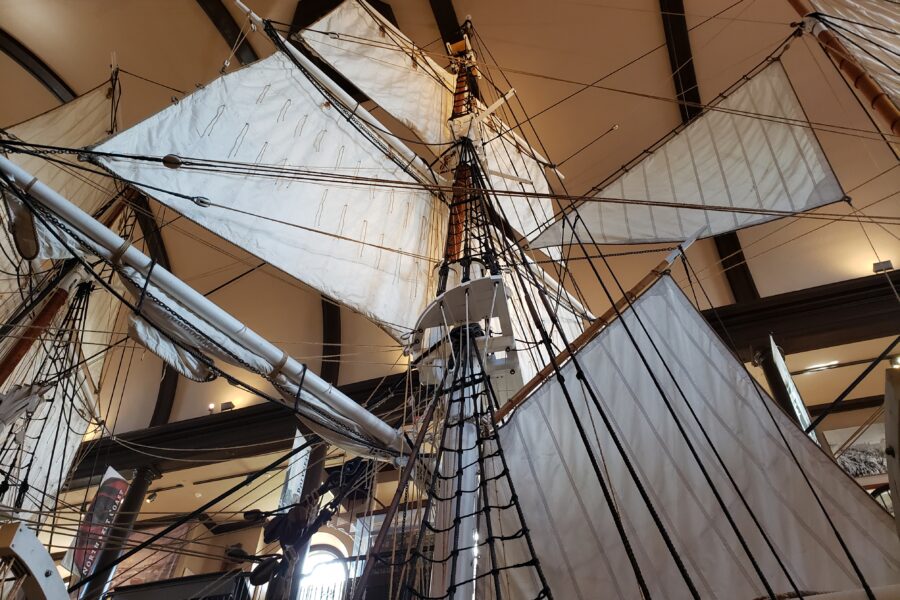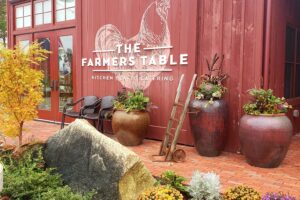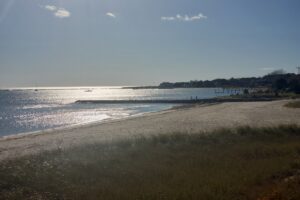Finding Our Way
Yesterday Michael told me he wanted to go to New Bedford today. So, we are here. I’m not really sure why, I thought this was the town we drove through more often than any other as we would make our way to Newport, RI, and the Navy Base Exchange, where we would buy our groceries every two weeks. But it isn’t. My map tells me that was Fall River, another place to see. Another day.
New Bedford Whaling National Historical Park
Downtown, across from the harbor, we carefully feel our way (Michael shuns the use of Google Maps on my phone and prefers his memory and signs) on streets paved with worn bricks, and the old interspersed with the new as far as buildings are concerned. We follow the signs to the parking garage for the New Bedford Whaling National Historical Park. Then we drive right by, deciding to look for the Whaling Museum instead. Google Maps takes us there.
We arrive alongside a big, dark, red brick building, and both of us think this must be wrong. There are no signs. Nothing to indicate anything. We think Google Maps has lost its mind.

We return to the parking garage, walk across the street and follow signs one more time, but this time to the Visitor Center. Warmly greeted, by the attendant, she hurries us through double doors leading to a theater. The 20 minute introductory film is about to begin. She doesn’t want us to miss it. They promise not to begin the film till they see we are seated.
The film is excellent. The quality of the information and the manor of delivery is impressive; informative, educational; portrayed by actors and narrated by Tom Hanks.
Back in the lobby of the Visitor Center, a friendly park ranger asks Michael what we would like to know. Michael’s answer is, “Everything!”
The ranger smiles and asks if we have eight hours or so to hear it all. When we both say yes, he is a bit shocked but proceeds to fill us in on many fronts. The final one is a recommendation on where to have lunch. “Delicious,” he says.
Closed. We discover.
Tia Maria’s

So we ask the receptionist at the privately owned Whaling Museum where she suggests. She tells us that there is a Portuguese restaurant right across the street. She goes there everyday for lunch. I like that it is Portuguese.
Tia Maria’s European Café is open, and we find an empty table. It is well past lunch time but the restaurant is still half-full. I remember linguicia Portuguese sausage from long ago, and the way a woman I worked with at Geilich Tanning Company (the company that was kind enough to take a chance on a young girl whose husband was in the US Army and they could only guess how long I would be working there—not half long enough it turned out) spoke about how good it was.

So I look for that ingredient. The menu is long—almost as long as a TGI Friday’s menu. Everything sounds like too much or too American till I get to specialty sandwiches. We both find our perceived passions. I order a Chourico with Rodelas and Michael orders a Bifana.


When my sandwich arrives I determine it is simple peasant food—good on a whaling ship where there is no dripping and it can be eaten with one hand—it is nothing but meat and bread (maybe this is a Massachusetts thing, I think, remembering my naked bacon sandwich of last Friday).
My choice consists of spicy sliced sausage on the best sandwich roll I have ever eaten. I wish I could buy these at home. Michael’s sandwich is on the same type roll, extremely flavorful, lightly sauced, the meat tender and the peppers spicy. I prefer what he ordered, so he offers to switch. I would feel too guilty if I said yes.
The New Bedford Whaling Museum
Slightly more than just a whaling museum, The New Bedford Whaling Museum was founded in 1903, by the Old Dartmouth Historical Society, children of the progenitors of the American whaling industry, to create and perhaps foster an interest in the history of Old Dartmouth. (Now the cities of New Bedford, Acushnet, Dartmouth, Fairhaven and Westport in Massachusetts.)
We were told by the park ranger at the visitor center we could spend all day here. We have mere hours before it closes. Apparently, a leisurely morning can at times be problematic.

Learning About Whaling
After admiring the whale skeletons in the lobby, their size, scale and inner workings, we make our way to a very real theater to watch another film.
Whale oil, so clear so pure, it burns without smoke, made New Bedford not only the whaling capitol of the world, but also the richest town in America at one time. There is a season for everything it seems, all things come, peak, and then go, as did the whaling industry.
People all over the world have been hunting whales for over 4,000 years. However, in the 19th century some scientists estimate that more whales were hunted in the early 1900s than in the previous four centuries combined.
Feeding ground after feeding ground, in ocean after ocean whales were stalked killed and depleted. Every part of the whale was used, nothing wasted. Today some chefs say it is honoring the animals we kill for consumption. The needs of humans is apparently insatiable it seems, as is the greed.
Whaling brought more to New Bedford than just wealth, it brought diversity from all over the world, and brought news and native ship hands back to America from far off places that were never even dreamed about by residents of New England.
The Museum
We begin our tour and it starts with the Puritans and the Native American Wampanoag tribe. My sadness and amazement increase as I read, in a bit more detail, some of the hints on the storyboards that I read yesterday.


The museum is full of artifacts and art. To examine and appreciate each item, or even a corner of each very detailed painting, would take days, not hours. As I progress and see all there is to read and discover I change my time estimate to months, not days.
I hope the residents of New Bedford take advantage of this museum. It is amazing. Any individual at any age would find something here that intrigued them.
This museum is more than the story of whales and whaling. It is also the story of the people that lived here, and the underground railway in New Bedford, and the mills that grew when the whaling industry died.

Michael walks through a hallway seemingly leading nowhere and arrives on a deck overlooking the harbor. I find him there wistfully looking at the docks and a myriad of fishing boats.

The Lagoda

We walk through another door, discovering a whaling ship in our midst—the Lagoda, a 19th century whaling ship. Not a full size ship but a scale model, one half the size of the real one. We walk up some steps and experience the deck of the Lagoda, then take a tiny tour around the space. The deck is not empty but full of the necessities of the whaling life—a child would be all over it, with parents hopefully restraining their enthusiasm.
Back on the ground we walk around the perimeter of the Lagoda. The room that holds it is enormous. A balcony runs the length and width on both sides, so that museum goers may get a better look at the ship from above. The sides on all levels are filled with displays. Storyboards. More history.


Fort Rodman
Michael discovers that there is a fort in New Bedford with a lighthouse in the middle of it, so, obviously there is no choice in the matter. We have to go.



By the time we arrive the wind has kicked up, and the air it churns has turned cold. I grab a wool scarf for my neck and my lightweight all weather coat, following my intrepid adventurer where ever the winds may take him. And of course, eventually, they take him up hill. I’m married to a kid; a very smart, sweet, thoughtful, considerate kid. But a kid. He was born to explore.

























Leave a Reply
Your email is safe with us.